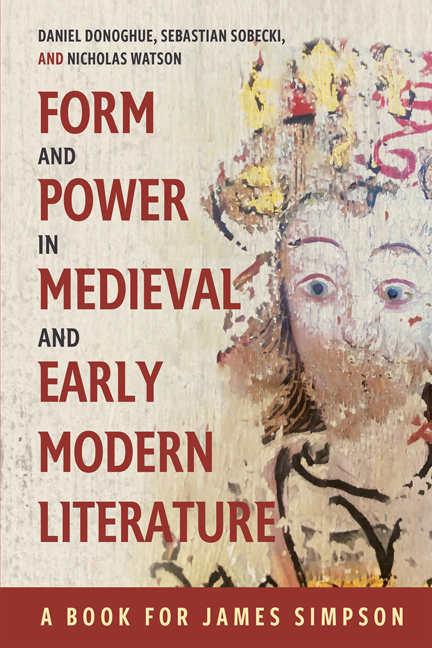Book contents
- Frontmatter
- Contents
- List of Illustrations
- Contributors and Editors
- Acknowledgments
- List of Abbreviations
- Simpson: An Interim Report
- PART I THE HERMENEUTICS OF RECOGNITION
- PART II GENRE AND FIGURE
- PART III CULTURE AND INSTITUTIONS
- PART IV REFORMATIONS
- James Simpson’s Publications from 1984 to 2024
- Bibliography
- A Note on the Bloomfield Conferences
- General Index
- Tabula Gratulatoria
13 - Rewriting Robert the Devil: Thomas Lodge and Medieval Romance
Published online by Cambridge University Press: 17 May 2024
- Frontmatter
- Contents
- List of Illustrations
- Contributors and Editors
- Acknowledgments
- List of Abbreviations
- Simpson: An Interim Report
- PART I THE HERMENEUTICS OF RECOGNITION
- PART II GENRE AND FIGURE
- PART III CULTURE AND INSTITUTIONS
- PART IV REFORMATIONS
- James Simpson’s Publications from 1984 to 2024
- Bibliography
- A Note on the Bloomfield Conferences
- General Index
- Tabula Gratulatoria
Summary
“Romance survives the Tudor revolution,” notes James Simpson: “While the events of the 1530s and 1550s provoked the radical limitation or the official repudiation of many varieties of Middle English writing, romance continued to be produced.” The essay that follows uses Thomas Lodge's Famous, True and Historicall Life of Robert, Second Duke of Normandy (1591) to examine how one such romance – in Simpson's words – “adapt[ed] to new discursive, commercial, and political environments.” In particular, this essay traces how Lodge's text reflects the impact of humanism and religious reformation in later Elizabethan England. It explores how Lodge's recourse to seemingly “papist” material is inflected by his confessional position, but also how it challenges reformist polemic which painted romances as morally-corrupting works, made for pleasure and time-wasting, by using romance to make moral and political arguments, and – as Edmund Spenser does from a Calvinist perspective in The Faerie Queene (1590) – to try to cultivate an active, ethically engaged readership.
The legend of Robert the Devil comes into English from France where it has a long literary tradition, in verse, prose, and drama; in Latin and the vernacular, going back until at least the thirteenth century. Prior to Lodge's Life, there were at least four English versions: two lost plays (performed in Lincoln in 1453 and Chester in 1529); a prose account, The Lyf of the Moste Myschevoust Robert the Devyll, published by Wynkyn de Worde, around 1500 (second edition 1517?), which is translated fairly faithfully from La Vie de terrible Robert le Diable (first printed in Lyon in 1496); and a version in metrical verse, derived from de Worde's Lyf, printed, probably by Richard Pynson, around 1510. Aside from a small fragment in the Bodleian Library, Oxford (MS Douce, Fragmn. f. 4), this version only survives in a mid-sixteenth-century manuscript transcription (London, British Library MS Egerton 3132A), which seems to have belonged to a recusant named Edward Banyster.
These multiple versions share the same basic plot. The Duke and Duchess of Normandy, long-married, lack an heir, until – in despair – the Duchess abandons praying to God for a child and instead pledges any baby that she conceives to the devil. From the outset, the resulting child (Robert) is trouble. He is born in a prodigious storm, after a protracted labor (as much as a month long in some versions).
- Type
- Chapter
- Information
- Form and Power in Medieval and Early Modern LiteratureA Book for James Simpson, pp. 241 - 258Publisher: Boydell & BrewerPrint publication year: 2024

